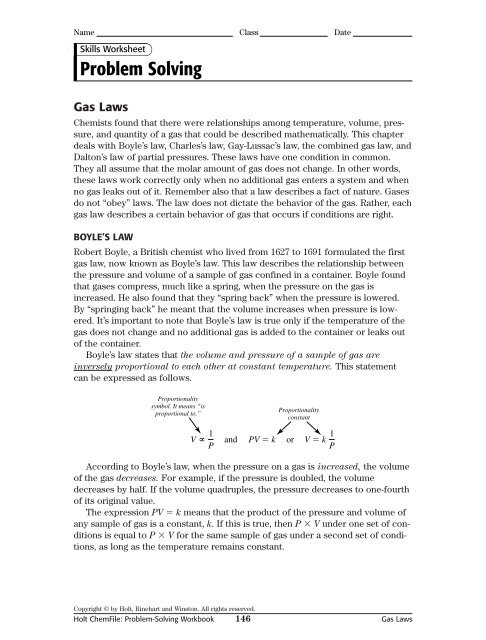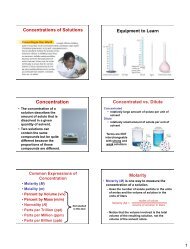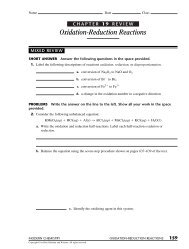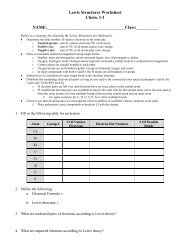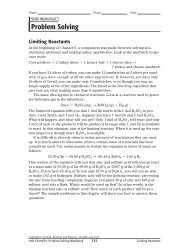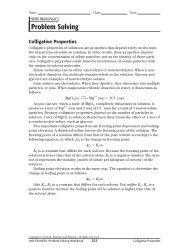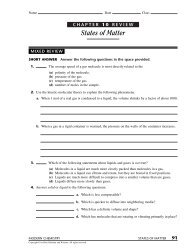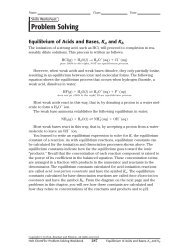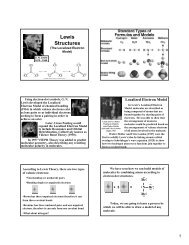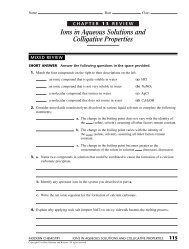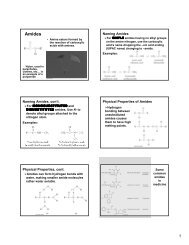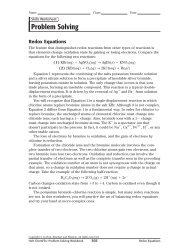Gas Laws - Lower Cape May Regional School District
Gas Laws - Lower Cape May Regional School District
Gas Laws - Lower Cape May Regional School District
Create successful ePaper yourself
Turn your PDF publications into a flip-book with our unique Google optimized e-Paper software.
Name Class Date<br />
Skills Worksheet<br />
Problem Solving<br />
<strong>Gas</strong> <strong>Laws</strong><br />
Chemists found that there were relationships among temperature, volume, pressure,<br />
and quantity of a gas that could be described mathematically. This chapter<br />
deals with Boyle’s law, Charles’s law, Gay-Lussac’s law, the combined gas law, and<br />
Dalton’s law of partial pressures. These laws have one condition in common.<br />
They all assume that the molar amount of gas does not change. In other words,<br />
these laws work correctly only when no additional gas enters a system and when<br />
no gas leaks out of it. Remember also that a law describes a fact of nature. <strong>Gas</strong>es<br />
do not “obey” laws. The law does not dictate the behavior of the gas. Rather, each<br />
gas law describes a certain behavior of gas that occurs if conditions are right.<br />
BOYLE’S LAW<br />
Robert Boyle, a British chemist who lived from 1627 to 1691 formulated the first<br />
gas law, now known as Boyle’s law. This law describes the relationship between<br />
the pressure and volume of a sample of gas confined in a container. Boyle found<br />
that gases compress, much like a spring, when the pressure on the gas is<br />
increased. He also found that they “spring back” when the pressure is lowered.<br />
By “springing back” he meant that the volume increases when pressure is lowered.<br />
It’s important to note that Boyle’s law is true only if the temperature of the<br />
gas does not change and no additional gas is added to the container or leaks out<br />
of the container.<br />
Boyle’s law states that the volume and pressure of a sample of gas are<br />
inversely proportional to each other at constant temperature. This statement<br />
can be expressed as follows.<br />
Proportionality<br />
symbol. It means “is<br />
proportional to.”<br />
Proportionality<br />
constant<br />
V 1 P<br />
and<br />
PV k<br />
or<br />
V k<br />
1<br />
P<br />
According to Boyle’s law, when the pressure on a gas is increased, the volume<br />
of the gas decreases. For example, if the pressure is doubled, the volume<br />
decreases by half. If the volume quadruples, the pressure decreases to one-fourth<br />
of its original value.<br />
The expression PV k means that the product of the pressure and volume of<br />
any sample of gas is a constant, k. If this is true, then P V under one set of conditions<br />
is equal to P V for the same sample of gas under a second set of conditions,<br />
as long as the temperature remains constant.<br />
Copyright © by Holt, Rinehart and Winston. All rights reserved.<br />
Holt ChemFile: Problem-Solving Workbook 146 <strong>Gas</strong> <strong>Laws</strong>
Name Class Date<br />
Problem Solving continued<br />
Boyle’s law can be expressed by the following mathematical equation.<br />
P 1<br />
V 1<br />
P 2<br />
V 2<br />
Pressure under<br />
the first set of<br />
conditions<br />
<br />
Volume under<br />
the first set of<br />
conditions<br />
<br />
Pressure under<br />
the second set<br />
of conditions<br />
Volume under<br />
the second set<br />
of conditions<br />
General Plan for Solving Boyle's-Law Problems<br />
1<br />
Given three of the following<br />
four quantities:<br />
P 1<br />
, V 1<br />
, P 2<br />
, V 2<br />
Rearrange the equation<br />
P 1<br />
V 1<br />
P 2<br />
V 2<br />
algebraically to solve for<br />
the unknown quantity.<br />
2<br />
An equation that can be used to<br />
calculate the unknown quantity<br />
It will be one of the following four:<br />
V 2<br />
<br />
P V 1 1 , P<br />
P 2<br />
1<br />
V 1<br />
, P<br />
V ,<br />
1<br />
2<br />
V 2<br />
P<br />
P 1<br />
2<br />
V 2<br />
P 1<br />
P 2<br />
V 2<br />
V 1<br />
Substitute each of the<br />
known quantities,<br />
and calculate.<br />
3<br />
Unknown<br />
P or V<br />
Copyright © by Holt, Rinehart and Winston. All rights reserved.<br />
Holt ChemFile: Problem-Solving Workbook 147 <strong>Gas</strong> <strong>Laws</strong>
Name Class Date<br />
Problem Solving continued<br />
Sample Problem 1<br />
A sample of nitrogen collected in the laboratory occupies a volume of<br />
725 mL at a pressure of 0.971 atm. What volume will the gas occupy at a<br />
pressure of 1.40 atm, assuming the temperature remains constant?<br />
Solution<br />
ANALYZE<br />
What is given in the problem?<br />
What are you asked to find?<br />
the original volume and pressure of the nitrogen<br />
sample, and the new pressure of the sample<br />
the volume at the new pressure<br />
Items<br />
Original pressure, P 1<br />
Data<br />
0.971 atm<br />
Original pressure, V 1 725 mL N 2<br />
New pressure, P 2 1.40 atm<br />
New volume, V 2 ? mL N 2<br />
PLAN<br />
What steps are needed to calculate the new volume of the gas?<br />
Rearrange the Boyle’s law equation to solve for V 2 , substitute known quantities,<br />
and calculate.<br />
to solve for V 2<br />
,<br />
divide both sides of<br />
1<br />
the equation by P 2<br />
to<br />
isolate V<br />
P<br />
2<br />
2<br />
V 2 insert data and solve for V 2<br />
<br />
P2<br />
P<br />
P 1<br />
V 1<br />
V 1<br />
1<br />
V 2<br />
<br />
COMPUTE<br />
Substitute data for the terms of the equation, and compute the result.<br />
P<br />
V 2 1 V 1 0.971 atm<br />
725 mL N<br />
<br />
2<br />
503 mL N 2<br />
1.40 atm <br />
EVALUATE<br />
Are the units correct?<br />
Yes; units canceled to give mL N 2 .<br />
Is the number of significant figures correct?<br />
Yes; the number of significant figures is correct because data were given to<br />
three significant figures.<br />
Is the answer reasonable?<br />
Yes; pressure increased by about 1/3, volume must decrease by about 1/3.<br />
2<br />
P 2<br />
Copyright © by Holt, Rinehart and Winston. All rights reserved.<br />
Holt ChemFile: Problem-Solving Workbook 148 <strong>Gas</strong> <strong>Laws</strong>
Name Class Date<br />
Problem Solving continued<br />
Practice<br />
In each of the following problems, assume that the temperature and molar quantity<br />
of gas do not change.<br />
1. Calculate the unknown quantity in each of the following measurements of<br />
gases.<br />
P 1 V 1 P 2 V 2<br />
a. 3.0 atm 25 mL 6.0 atm ? mL<br />
b. 99.97 kPa 550. mL ? kPa 275 mL<br />
c. 0.89 atm ? L 3.56 atm 20.0 L<br />
d. ? kPa 800. mL 500. kPa 160. mL<br />
e. 0.040 atm ? L 250 atm 1.0 10 2 L<br />
ans: 13 mL<br />
ans: 200. kPa<br />
ans: 80. L<br />
ans: 100. kPa<br />
ans: 63 L<br />
Copyright © by Holt, Rinehart and Winston. All rights reserved.<br />
Holt ChemFile: Problem-Solving Workbook 149 <strong>Gas</strong> <strong>Laws</strong>
Name Class Date<br />
Problem Solving continued<br />
2. A sample of neon gas occupies a volume of 2.8 L at 1.8 atm. What will its<br />
volume be at 1.2 atm? ans: 4.2 L<br />
3. To what pressure would you have to compress 48.0 L of oxygen gas at 99.3<br />
kPa in order to reduce its volume to 16.0 L? ans: 298 kPa<br />
4. A chemist collects 59.0 mL of sulfur dioxide gas on a day when the atmospheric<br />
pressure is 0.989 atm. On the next day, the pressure has changed to<br />
0.967 atm. What will the volume of the SO 2 gas be on the second day?<br />
ans: 60.3 mL<br />
5. 2.2 L of hydrogen at 6.5 atm pressure is used to fill a balloon at a final pressure<br />
of 1.15 atm. What is its final volume? ans: 12 L<br />
CHARLES’S LAW<br />
The French physicist Jacques Charles carried out experiments in 1786 and 1787<br />
that showed a relationship between the temperature and volume of gases at constant<br />
pressure. You know that most matter expands as its temperature rises.<br />
<strong>Gas</strong>es are no different. When Benjamin Thomson and Lord Kelvin proposed an<br />
absolute temperature scale in 1848, it was possible to set up the mathematical<br />
expression of Charles’s law.<br />
Copyright © by Holt, Rinehart and Winston. All rights reserved.<br />
Holt ChemFile: Problem-Solving Workbook 150 <strong>Gas</strong> <strong>Laws</strong>
Name Class Date<br />
Problem Solving continued<br />
Charles’s law states that the volume of a sample of gas is directly proportional<br />
to the absolute temperature when pressure remains constant. Charles’s<br />
law can be expressed as follows.<br />
V T and V k, or V kT<br />
T<br />
According to Charles’s law, when the temperature of a sample of gas increases,<br />
the volume of the gas increases by the same factor. Therefore, doubling the<br />
Kelvin temperature of a gas will double its volume. Reducing the Kelvin temperature<br />
by 25% will reduce the volume by 25%.<br />
The expression V/T k means that the result of volume divided by temperature<br />
is a constant, k, for any sample of gas. If this is true, then V/T under one set<br />
of conditions is equal to V/T for the same sample of gas under another set of conditions,<br />
as long as the pressure remains constant.<br />
Charles’s law can be expressed by the following mathematical equation.<br />
V1<br />
V <br />
2<br />
T T<br />
1<br />
General Plan for Solving Charles’s-Law Problems<br />
2<br />
1<br />
Given three of the following<br />
four quantities:<br />
T 1<br />
, V 1<br />
, T 2<br />
, V 2<br />
Rearrange the equation<br />
V 1<br />
T 1<br />
<br />
V 2<br />
T 2<br />
algebraically to solve for<br />
the unknown quantity.<br />
2<br />
An equation that can be used to<br />
calculate the unknown quantity<br />
It will be one of the following four:<br />
T 2<br />
V 1<br />
T<br />
,<br />
1<br />
V 2<br />
T<br />
<br />
1<br />
V 2<br />
T<br />
V 2<br />
T <br />
T 2<br />
, V 2<br />
V<br />
1<br />
, T 1<br />
1<br />
1<br />
V 1<br />
T 2<br />
V 2<br />
Convert Celsius<br />
temperatures to<br />
Kelvin temperatures<br />
if necessary.<br />
Substitute each of the<br />
known quantities,<br />
and compute.<br />
3<br />
Unknown<br />
T or V<br />
Convert<br />
K to C if<br />
needed.<br />
Unknown<br />
t in C<br />
Copyright © by Holt, Rinehart and Winston. All rights reserved.<br />
Holt ChemFile: Problem-Solving Workbook 151 <strong>Gas</strong> <strong>Laws</strong>
Name Class Date<br />
Problem Solving continued<br />
Sample Problem 2<br />
A container of oxygen has a volume of 349 mL at a temperature of 22°C.<br />
What volume will the gas occupy at 50.°C?<br />
Solution<br />
ANALYZE<br />
What is given in the problem?<br />
What are you asked to find?<br />
Items<br />
the original volume and temperature of the<br />
oxygen sample, and the new temperature of the<br />
sample<br />
the volume at the new temperature<br />
Data<br />
Original volume, V 1 349 mL O 2<br />
Original temperature, t 1 22°C<br />
Original Kelvin temperature, T 1<br />
New volume, V 2 ? mL O 2<br />
New temperature, t 2<br />
New Kelvin temperature, T 2<br />
(22 273) K 295 K<br />
50.°C<br />
? (50. 273) K 323 K<br />
PLAN<br />
What steps are needed to calculate the new volume of the gas?<br />
Rearrange the Charles’s law equation to solve for V 2 , substitute known quantities,<br />
and calculate.<br />
V 1<br />
1<br />
T 1<br />
<br />
V 2<br />
T 2<br />
to solve for V 2<br />
,<br />
multiply both sides of<br />
the equation by T 2<br />
to<br />
2<br />
isolate V 2<br />
V 1<br />
T 2<br />
V<br />
insert data and solve for V 2 T 2<br />
1<br />
COMPUTE<br />
Substitute data for the terms of the equation, and compute the result.<br />
V 2 V 1T2<br />
349 mL O<br />
2 323 K<br />
382 mL O 2<br />
T<br />
295 K<br />
Copyright © by Holt, Rinehart and Winston. All rights reserved.<br />
1<br />
EVALUATE<br />
Are the units correct?<br />
Yes; units canceled to give mL O 2 .<br />
Is the number of significant figures correct?<br />
Yes; the number of significant figures is correct because data were given to<br />
three significant figures.<br />
Is the answer reasonable?<br />
Yes; the temperature increased, so the volume must also increase.<br />
Holt ChemFile: Problem-Solving Workbook 152 <strong>Gas</strong> <strong>Laws</strong>
Name Class Date<br />
Problem Solving continued<br />
Practice<br />
In each of the following problems, assume that the pressure and molar quantity of<br />
gas do not change.<br />
1. Calculate the unknown quantity in each of the following measurements of<br />
gases.<br />
V 1 T 1 V 2 T 2<br />
a. 40.0 mL 280. K ? mL 350. K<br />
b. 0.606 L 300. K 0.404 L ? K<br />
c. ? mL 292 K 250. mL 365 K<br />
d. 100. mL ? K 125 mL 305 K<br />
e. 0.0024 L 22°C ? L 14°C<br />
ans: 50.0 mL<br />
ans: 200. K<br />
ans: 200. mL<br />
ans: 244 K<br />
ans: 0.0021 L<br />
Copyright © by Holt, Rinehart and Winston. All rights reserved.<br />
Holt ChemFile: Problem-Solving Workbook 153 <strong>Gas</strong> <strong>Laws</strong>
Name Class Date<br />
Problem Solving continued<br />
2. A balloon full of air has a volume of 2.75 L at a temperature of 18°C. What is<br />
the balloon’s volume at 45°C? ans: 3.01 L<br />
3. A sample of argon has a volume of 0.43 mL at 24°C. At what temperature in<br />
degrees Celsius will it have a volume of 0.57 mL? ans: 121°C<br />
GAY-LUSSAC’S LAW<br />
You may have noticed a warning on an aerosol spray can that says something<br />
similar to Do not incinerate! Do not expose to temperatures greater than 140°F!<br />
Warnings such as this appear because the pressure of a confined gas increases<br />
with increasing temperature. If the temperature of the can increases enough, the<br />
can will explode because of the pressure that builds up inside of it.<br />
The relationship between the pressure and temperature of a gas is described<br />
by Gay-Lussac’s law. Gay-Lussac’s law states that the pressure of a sample of gas<br />
is directly proportional to the absolute temperature when volume remains constant.<br />
Gay-Lussac’s law can be expressed as follows.<br />
P T and P k, or P kT<br />
T<br />
According to Gay-Lussac’s law, when the temperature of a sample of gas<br />
increases, the pressure of the gas increases by the same factor. Therefore, doubling<br />
the temperature of a gas will double its pressure. Reducing the temperature<br />
of a gas to 75% of its original value will also reduce the pressure to 75% of its<br />
original value.<br />
The expression P/T k means that the result of pressure divided by temperature<br />
is a constant, k, for any sample of gas. If this is true, then P/T under one set<br />
of conditions is equal to P/T for the same sample of gas under another set of conditions,<br />
as long as the volume remains constant.<br />
Copyright © by Holt, Rinehart and Winston. All rights reserved.<br />
Holt ChemFile: Problem-Solving Workbook 154 <strong>Gas</strong> <strong>Laws</strong>
Name Class Date<br />
Problem Solving continued<br />
Gay-Lussac’s law can be expressed by the following mathematical equation.<br />
P1<br />
P <br />
2<br />
T T<br />
1<br />
General Plan for Solving Gay-Lussac’s-Law Problems<br />
2<br />
1<br />
Given three of the following<br />
four quantities:<br />
T 1<br />
, P 1<br />
, T 2<br />
, P 2<br />
Rearrange the equation<br />
P 1<br />
T 1<br />
<br />
P 2<br />
T 2<br />
algebraically to solve for<br />
the unknown quantity.<br />
2<br />
An equation that can be used to<br />
calculate the unknown quantity<br />
It will be one of the following four:<br />
T 2<br />
P 1<br />
T<br />
,<br />
1<br />
P 2<br />
T<br />
<br />
1<br />
P 2<br />
T<br />
P 2<br />
T <br />
T 2<br />
, P 2<br />
P<br />
1<br />
, T 1<br />
1<br />
1<br />
P 1<br />
T 2<br />
P 2<br />
Convert Celsius<br />
temperatures to<br />
Kelvin temperatures<br />
if necessary.<br />
Substitute each of the<br />
known quantities,<br />
and compute.<br />
3<br />
Unknown<br />
T or P<br />
Convert<br />
K to C if<br />
needed.<br />
Unknown<br />
t in C<br />
Copyright © by Holt, Rinehart and Winston. All rights reserved.<br />
Holt ChemFile: Problem-Solving Workbook 155 <strong>Gas</strong> <strong>Laws</strong>
Name Class Date<br />
Problem Solving continued<br />
Sample Problem 3<br />
A cylinder of gas has a pressure of 4.40 atm at 25°C. At what temperature<br />
in °C will it reach a pressure of 6.50 atm?<br />
Solution<br />
ANALYZE<br />
What is given in the problem?<br />
What are you asked to find?<br />
the original pressure and temperature of the<br />
gas in the cylinder, and the new pressure of the<br />
sample<br />
the temperature at which the gas reaches the<br />
specified pressure<br />
Items<br />
Data<br />
Original pressure, P 1<br />
4.40 atm<br />
Original temperature, t 1 25°C<br />
Original Kelvin temperature, T 1 (25 273) K 298 K<br />
New pressure, P 2<br />
6.50 atm<br />
New temperature, t 2<br />
?°C<br />
New Kelvin temperature, T 2 ? K<br />
PLAN<br />
What steps are needed to calculate the new temperature of the gas?<br />
Rearrange the Gay-Lussac’s law equation to solve for T 2 , substitute known<br />
quantities, and calculate.<br />
1<br />
P 1<br />
P<br />
2<br />
T 1<br />
T 2<br />
to solve for T 2<br />
, divide<br />
both sides of the equation<br />
by P 2<br />
and invert the<br />
2<br />
equality to isolate T 2<br />
T 1<br />
P 2<br />
T<br />
insert data and solve for T 2 P 2<br />
1<br />
COMPUTE<br />
Substitute data for the terms of the equation, and compute the result.<br />
T 2 T 1P2<br />
298 K 6.<br />
50atm<br />
440. K<br />
P1<br />
4.40m<br />
at<br />
Convert back to °C.<br />
440. K (440. 273)°C 167°C<br />
EVALUATE<br />
Are the units correct?<br />
Yes; units canceled to give Kelvin temperature, which was converted to °C.<br />
Copyright © by Holt, Rinehart and Winston. All rights reserved.<br />
Holt ChemFile: Problem-Solving Workbook 156 <strong>Gas</strong> <strong>Laws</strong>
Name Class Date<br />
Problem Solving continued<br />
Is the number of significant figures correct?<br />
Yes; the number of significant figures is correct because the data were given to<br />
three significant figures.<br />
Is the answer reasonable?<br />
Yes; the pressure increases, so the temperature must also increase.<br />
Practice<br />
In each of the following problems, assume that the volume and molar quantity of<br />
gas do not change.<br />
1. Calculate the unknown quantity in each of the following measurements of<br />
gases:<br />
P 1 T 1 P 2 T 2<br />
a. 1.50 atm 273 K ? atm 410 K<br />
b. 0.208 atm 300. K 0.156 atm ? K<br />
c. ? kPa 52°C 99.7 kPa 77°C<br />
d. 5.20 atm ?°C 4.16 atm 13°C<br />
e. 8.33 10 4 atm 84°C 3.92 10 3 atm ?°C<br />
ans: 2.25 atm<br />
ans: 225 K<br />
ans: 92.6 kPa<br />
ans: 52°C<br />
ans: 616°C<br />
Copyright © by Holt, Rinehart and Winston. All rights reserved.<br />
Holt ChemFile: Problem-Solving Workbook 157 <strong>Gas</strong> <strong>Laws</strong>
Name Class Date<br />
Problem Solving continued<br />
2. A cylinder of compressed gas has a pressure of 4.882 atm on one day. The<br />
next day, the same cylinder of gas has a pressure of 4.690 atm, and its temperature<br />
is 8°C. What was the temperature on the previous day in °C? ans: 20.°C<br />
3. A mylar balloon is filled with helium gas to a pressure of 107 kPa when the<br />
temperature is 22°C. If the temperature changes to 45°C, what will be the<br />
pressure of the helium in the balloon? ans: 115 kPa<br />
THE COMBINED GAS LAW<br />
Look at the relationships among temperature, volume, and pressure of a gas that<br />
you have studied so far.<br />
Boyle’s law<br />
At constant<br />
temperature:<br />
PV k<br />
Charles’s law<br />
At constant pressure:<br />
V<br />
T k<br />
Gay-Lussac’s law<br />
At constant volume:<br />
P<br />
T k<br />
Notice in these proportions that while P and V are inversely proportional to<br />
each other, they are each directly proportional to temperature. These three gas<br />
laws can be combined in one combined gas law. This law can be expressed as<br />
follows.<br />
PV k<br />
T<br />
If PV/T equals a constant, k, then PV/T for a sample of gas under one set of<br />
conditions equals PV/T under another set of conditions, assuming the amount of<br />
gas remains the same.<br />
Therefore, the combined gas law can be expressed by the following mathematical<br />
equation. This equation can be used to solve problems in which pressure,<br />
Copyright © by Holt, Rinehart and Winston. All rights reserved.<br />
Holt ChemFile: Problem-Solving Workbook 158 <strong>Gas</strong> <strong>Laws</strong>
Name Class Date<br />
Problem Solving continued<br />
volume, and temperature of a gas vary. Only the molar quantity of the gas must<br />
be constant.<br />
P<br />
<br />
1V1<br />
P 2V2<br />
<br />
T T<br />
1<br />
General Plan for Solving Combined-<strong>Gas</strong>-Law Problems<br />
2<br />
1<br />
Given five of the following<br />
six quantities:<br />
V 1<br />
,T 1<br />
, P 1<br />
, V 2<br />
,T 2<br />
, P 2<br />
Rearrange the equation<br />
P 1<br />
V 1<br />
P<br />
2<br />
V 2<br />
T 1<br />
T 2<br />
algebraically to solve for<br />
the unknown quantity.<br />
2<br />
An equation that can be used to<br />
calculate the unknown quantity<br />
Convert Celsius<br />
temperatures to<br />
Kelvin temperatures<br />
if necessary.<br />
Substitute each of the<br />
known quantities,<br />
and compute.<br />
3<br />
Unknown<br />
V, T, or P<br />
Convert<br />
K to C if<br />
needed.<br />
Unknown<br />
t in C<br />
Copyright © by Holt, Rinehart and Winston. All rights reserved.<br />
Holt ChemFile: Problem-Solving Workbook 159 <strong>Gas</strong> <strong>Laws</strong>
Name Class Date<br />
Problem Solving continued<br />
Sample Problem 4<br />
A sample of hydrogen gas has a volume of 65.0 mL at a pressure of 0.992<br />
atm and a temperature of 16°C. What volume will the hydrogen occupy at<br />
0.984 atm and 25°C?<br />
Solution<br />
ANALYZE<br />
What is given in the problem?<br />
What are you asked to find?<br />
the original volume, pressure, and temperature<br />
of the hydrogen, and the new pressure and temperature<br />
of the hydrogen<br />
the volume at the new temperature and<br />
pressure<br />
Items<br />
Data<br />
Original volume, V 1<br />
65.0 mL<br />
Original pressure, P 1<br />
0.992 atm<br />
Original temperature, t 1 16°C<br />
Original Kelvin temperature, T 1 (16 273) K 289 K<br />
New volume, V 2<br />
?mL<br />
New pressure, P 2<br />
0.984 atm<br />
New temperature, t 2 25°C<br />
New Kelvin temperature, T 2 (25 273) K 298 K<br />
PLAN<br />
What steps are needed to calculate the new volume of the gas?<br />
Rearrange the combined gas law equation to solve for V 2 , substitute known<br />
quantities, and calculate.<br />
1<br />
P 1<br />
V 1<br />
<br />
T 1<br />
P 2<br />
V 2<br />
T 2<br />
to solve for V 2<br />
,<br />
multiply both sides of<br />
the equation by T 2<br />
/P 2<br />
to<br />
isolate V 2<br />
T 2<br />
P 1<br />
V 1<br />
V<br />
insert data and solve for V 2 P 2<br />
T 2<br />
1<br />
2<br />
COMPUTE<br />
Substitute data for the terms of the equation, and compute the result.<br />
V 2 T 2P1V1<br />
298 K 0.992 atm<br />
65.0 mL H<br />
<br />
2<br />
67.6 mL H 2<br />
P2T1<br />
0.984 atm 289 K<br />
EVALUATE<br />
Are the units correct?<br />
Yes; units canceled to give mL of H 2 .<br />
Copyright © by Holt, Rinehart and Winston. All rights reserved.<br />
Holt ChemFile: Problem-Solving Workbook 160 <strong>Gas</strong> <strong>Laws</strong>
Name Class Date<br />
Problem Solving continued<br />
Is the number of significant figures correct?<br />
Yes; the number of significant figures is correct because data were given to<br />
three significant figures.<br />
Is the answer reasonable?<br />
Yes; the temperature increases, and the pressure decreases, both of which have<br />
the effect of making the volume larger.<br />
Practice<br />
In each of the following problems, it is assumed that the molar quantity of gas<br />
does not change.<br />
1. Calculate the unknown quantity in each of the following measurements of<br />
gases.<br />
P 1 V 1 T 1 P 2 V 2 T 2<br />
a. 99.3 kPa 225 mL 15°C 102.8 kPa ? mL 24°C<br />
b. 0.959 atm 3.50 L 45°C ? atm 3.70 L 37°C<br />
c. 0.0036 atm 62 mL 373 K 0.0029 atm 64 mL ? K<br />
d. 100. kPa 43.2 mL 19°C 101.3 kPa ? mL 0°C<br />
ans: 224 mL<br />
ans: 0.884 atm<br />
ans: 310 K<br />
ans: 39.9 mL<br />
2. A student collects 450. mL of HCl(g) hydrogen chloride gas at a pressure of<br />
100. kPa and a temperature of 17°C. What is the volume of the HCl at 0°C and<br />
101.3 kPa? ans: 418 mL<br />
Copyright © by Holt, Rinehart and Winston. All rights reserved.<br />
Holt ChemFile: Problem-Solving Workbook 161 <strong>Gas</strong> <strong>Laws</strong>
Name Class Date<br />
Problem Solving continued<br />
DALTON’S LAW OF PARTIAL PRESSURES<br />
Air is a mixture of approximately 78% N 2 , 20% O 2 , 1% Ar, and 1% other gases by<br />
volume, so at any barometric pressure 78% of that pressure is exerted by nitrogen,<br />
20% by oxygen, and so on. This phenomenon is described by Dalton’s law of<br />
partial pressures, which says that the total pressure of a mixture of gases is<br />
equal to the sum of the partial pressures of the component gases. It can be<br />
stated mathematically as follows.<br />
P Total P <strong>Gas</strong> 1 P <strong>Gas</strong> 2 P <strong>Gas</strong> 3 P <strong>Gas</strong> 4 …<br />
A common method of collecting gas samples in the laboratory is to bubble the<br />
gas into a bottle filled with water and allow it to displace the water. When this<br />
technique is used, however, the gas collected in the bottle contains a small but<br />
significant amount of water vapor. As a result, the pressure of the gas that has<br />
displaced the liquid water is the sum of the pressure of the gas plus the vapor<br />
pressure of water at that temperature. The vapor pressures of water at various<br />
temperatures are given in Table 1 below.<br />
TABLE 1 VAPOR PRESSURE OF WATER<br />
Temp Vapor pressure Temp Vapor pressure Temp Vapor pressure<br />
in °C in kPa in °C in kPa in °C in kPa<br />
10 1.23 17 1.94 24 2.98<br />
11 1.31 18 2.06 25 3.17<br />
12 1.40 19 2.19 26 3.36<br />
13 1.50 20 2.34 27 3.57<br />
14 1.60 21 2.49 28 3.78<br />
15 1.71 22 2.64 29 4.01<br />
16 1.82 23 2.81 30 4.25<br />
P Total P <strong>Gas</strong> P H2 O vapor<br />
To find the true pressure of the gas alone, the pressure of the water vapor<br />
must be subtracted from the total pressure.<br />
P <strong>Gas</strong> P Total P H2 O vapor<br />
You can use this corrected pressure in gas-law calculations to determine what the<br />
volume of the gas alone would be.<br />
Copyright © by Holt, Rinehart and Winston. All rights reserved.<br />
Holt ChemFile: Problem-Solving Workbook 162 <strong>Gas</strong> <strong>Laws</strong>
Name Class Date<br />
Problem Solving continued<br />
Sample Problem 5<br />
A student collects oxygen gas by water displacement at a temperature of<br />
16°C. The total volume is 188 mL at a pressure of 92.3 kPa. What is the<br />
pressure of oxygen collected?<br />
Solution<br />
ANALYZE<br />
What is given in the problem?<br />
What are you asked to find?<br />
the total pressure, the fact that the gas was collected<br />
by water displacement, and the temperature<br />
the pressure of oxygen collected<br />
Items<br />
Data<br />
Total pressure, P total<br />
92.3 kPa<br />
Temperature 16°C<br />
Vapor pressure of water at 16°C, P H2 O*<br />
Pressure of collected O 2 , P O2<br />
1.82 kPa<br />
? kPa<br />
* determined from Table 1<br />
PLAN<br />
What step is needed to calculate the pressure of the oxygen collected?<br />
Use Dalton’s law of partial pressures to determine the pressure of the oxygen<br />
alone in the container.<br />
Use the following equation to determine the pressure of oxygen alone.<br />
given<br />
P O2<br />
P total <br />
from Table 1<br />
P H2 O vapor<br />
COMPUTE<br />
P O2<br />
P total P H2 O vapor 92.3 kPa 1.82 kPa 90.5 kPa<br />
EVALUATE<br />
Are the units correct?<br />
Yes; the units should be kPa.<br />
Is the number of significant figures correct?<br />
Yes; the number of significant figures is correct because the total pressure was<br />
given to one decimal place.<br />
Is the answer reasonable?<br />
Yes; the pressure of the collected oxygen and the water vapor add up to the<br />
total pressure of the system.<br />
Copyright © by Holt, Rinehart and Winston. All rights reserved.<br />
Holt ChemFile: Problem-Solving Workbook 163 <strong>Gas</strong> <strong>Laws</strong>
Name Class Date<br />
Problem Solving continued<br />
Practice<br />
1. A chemist collects a sample of H 2 S(g) over water at a temperature of 27°C.<br />
The total pressure of the gas that has displaced a volume of 15 mL of water is<br />
207.33 kPa. What is the pressure of the H 2 S gas collected? ans: 203.76 kPa<br />
Copyright © by Holt, Rinehart and Winston. All rights reserved.<br />
Holt ChemFile: Problem-Solving Workbook 164 <strong>Gas</strong> <strong>Laws</strong>
Name Class Date<br />
Problem Solving continued<br />
Sample Problem 6<br />
Chlorine gas is collected by water displacement at a temperature of 19°C.<br />
The total volume is 1.45 L at a pressure of 156.5 kPa. Assume that no<br />
chlorine gas dissolves in the water. What is the volume of chlorine corrected<br />
to STP?<br />
Solution<br />
ANALYZE<br />
What is given in the problem?<br />
What are you asked to find?<br />
the total initial volume, pressure, and temperature;<br />
the fact that the gas was collected by<br />
water displacement; and the final temperature<br />
and pressure of the chlorine<br />
the volume of chlorine at STP<br />
PLAN<br />
What steps are needed to calculate the volume of the chlorine at STP?<br />
Use Dalton’s law of partial pressures to determine the pressure of the chlorine<br />
alone in the container. Use the combined gas law to solve for the new volume.<br />
given from table<br />
P 1 P total PH2<br />
O vapor<br />
Calculate the volume of chlorine at STP using the following equation.<br />
P<br />
<br />
1V1<br />
P 2V2<br />
<br />
T T<br />
Solve for V 2 .<br />
Items<br />
Total original volume, V 1<br />
Total original pressure, P total<br />
Copyright © by Holt, Rinehart and Winston. All rights reserved.<br />
1<br />
calculated<br />
above given<br />
Holt ChemFile: Problem-Solving Workbook 165 <strong>Gas</strong> <strong>Laws</strong><br />
2<br />
P 1<br />
T 2<br />
V 1<br />
V2<br />
P 2<br />
T 1<br />
given<br />
Data<br />
1.45 L<br />
Original temperature, t 1 19°C<br />
Original Kelvin temperature, T 1<br />
Vapor pressure of water at 19°C, P H2 O<br />
Pressure of collected Cl 2 , P 1<br />
New volume, V 2<br />
New pressure, P 2<br />
156.5 kPa<br />
(19 273) K 292 K<br />
2.19 kPa<br />
? kPa<br />
?mL<br />
101.3 kPa<br />
New temperature, t 2 0°C<br />
New Kelvin temperature, T 2<br />
273 K
Name Class Date<br />
Problem Solving continued<br />
COMPUTE<br />
Determine the pressure of chlorine alone.<br />
P 1 P total P H2 O vapor 156.5 kPa 2.19 kPa 154.3 kPa<br />
Calculate the volume of Cl 2 at STP.<br />
154.3 kPa 273 K 1.45 L<br />
V 2 <br />
2.06 L<br />
101.3 kPa 292 K<br />
EVALUATE<br />
Are the units correct?<br />
Yes; the units canceled leaving the correct units, L.<br />
Is the number of significant figures correct?<br />
Yes; the number of significant figures is correct because the data were given to a<br />
minimum of three significant figures.<br />
Is the answer reasonable?<br />
Yes; the pressure decreased, so the volume had to increase.<br />
Practice<br />
In each of the following problems, assume that the molar quantity of gas does not<br />
change.<br />
1. Some hydrogen is collected over water at 10°C and 105.5 kPa pressure. The<br />
total volume of the sample was 1.93 L. Calculate the volume of the hydrogen<br />
corrected to STP. ans: 1.92 L<br />
2. One student carries out a reaction that gives off methane gas and obtains a<br />
total volume by water displacement of 338 mL at a temperature of 19°C and a<br />
pressure of 0.9566 atm. Another student does the identical experiment on<br />
another day at a temperature of 26°C and a pressure of 0.989 atm. Which<br />
student collected more CH 4 ? ans: The second student collected more CH 4 .<br />
Copyright © by Holt, Rinehart and Winston. All rights reserved.<br />
Holt ChemFile: Problem-Solving Workbook 166 <strong>Gas</strong> <strong>Laws</strong>
Name Class Date<br />
Problem Solving continued<br />
Additional Problems<br />
In each of the following problems, assume that the molar quantity of gas does not<br />
change.<br />
1. Calculate the unknown quantity in each of the following measurements of<br />
gases.<br />
P 1 V 1 P 2 V 2<br />
a. 127.3 kPa 796 cm 3 ? kPa 965 cm 3<br />
b. 7.1 10 2 atm ? mL 9.6 10 1 atm 3.7 10 3 mL<br />
c. ? kPa 1.77 L 30.79 kPa 2.44 L<br />
d. 114 kPa 2.93 dm 3 4.93 10 4 kPa ? dm 3<br />
e. 1.00 atm 120. mL ? atm 97.0 mL<br />
f. 0.77 atm 3.6 m 3 1.90 atm ? m 3<br />
2. A gas cylinder contains 0.722 m 3 of hydrogen gas at a pressure of 10.6 atm. If<br />
the gas is used to fill a balloon at a pressure of 0.96 atm, what is the volume in<br />
m 3 of the filled balloon?<br />
3. A weather balloon has a maximum volume of 7.50 10 3 L. The balloon<br />
contains 195 L of helium gas at a pressure of 0.993 atm. What will be the<br />
pressure when the balloon is at maximum volume?<br />
4. A rubber ball contains 5.70 10 1 dm 3 of gas at a pressure of 1.05 atm. What<br />
volume will the gas occupy at 7.47 atm?<br />
5. Calculate the unknown quantity in each of the following measurements of<br />
gases.<br />
V 1 T 1 V 2 T 2<br />
a. 26.5 mL ? K 32.9 mL 290. K<br />
b. ? dm 3 100.°C 0.83 dm 3 9°C<br />
c. 7.44 10 4 mm 3 870.°C 2.59 10 2 mm 3 ?°C<br />
d. 5.63 10 2 L 132 K ? L 190. K<br />
e. ?cm 3 243 K 819 cm 3 409 K<br />
f. 679 m 3 3°C ? m 3 246°C<br />
6. A bubble of carbon dioxide gas in some unbaked bread dough has a volume<br />
of 1.15 cm 3 at a temperature of 22°C. What volume will the bubble have when<br />
the bread is baked and the bubble reaches a temperature of 99°C?<br />
7. A perfectly elastic balloon contains 6.75 dm 3 of air at a temperature of 40.°C.<br />
What is the temperature if the balloon has a volume of 5.03 dm 3 ?<br />
Copyright © by Holt, Rinehart and Winston. All rights reserved.<br />
Holt ChemFile: Problem-Solving Workbook 167 <strong>Gas</strong> <strong>Laws</strong>
Name Class Date<br />
Problem Solving continued<br />
8. Calculate the unknown quantity in each of the following measurements of<br />
gases.<br />
P 1 T 1 P 2 T 2<br />
a. 0.777 atm ?°C 5.6 atm 192°C<br />
b. 152 kPa 302 K ? kPa 11 K<br />
c. ? atm 76°C 3.97 atm 27°C<br />
d. 395 atm 46°C 706 atm ?°C<br />
e. ? atm 37°C 350. atm 2050°C<br />
f. 0.39 atm 263 K 0.058 atm ? K<br />
9. A 2 L bottle containing only air is sealed at a temperature of 22°C and a<br />
pressure of 0.982 atm. The bottle is placed in a freezer and allowed to cool to<br />
3°C. What is the pressure in the bottle?<br />
10. The pressure in a car tire is 2.50 atm at a temperature of 33°C. What would<br />
the pressure be if the tire were allowed to cool to 0°C? Assume that the tire<br />
does not change volume.<br />
11. A container filled with helium gas has a pressure of 127.5 kPa at a temperature<br />
of 290. K. What is the temperature when the pressure is 3.51 kPa?<br />
12. Calculate the unknown quantity in each of the following measurements of<br />
gases.<br />
P 1 V 1 T 1 P 2 V 2 T 2<br />
a. 1.03 atm 1.65 L 19°C 0.920 atm ? L 46°C<br />
b. 107.0 kPa 3.79 dm 3 73°C ? kPa 7.58 dm 3 217°C<br />
c. 0.029 atm 249 mL ? K 0.098 atm 197 mL 293 K<br />
d. 113 kPa ? mm 3 12°C 149 kPa 3.18 10 3 mm 3 18°C<br />
e. 1.15 atm 0.93 m 3 22°C 1.01 atm 0.85 m 3 ?°C<br />
f. ? atm 156 cm 3 195 K 2.25 atm 468 cm 3 584 K<br />
13. A scientist has a sample of gas that was collected several days earlier. The<br />
sample has a volume of 392 cm 3 at a pressure of 0.987 atm and a temperature<br />
of 21°C. On the day the gas was collected, the temperature was 13°C and the<br />
pressure was 0.992 atm. What volume did the gas have on the day it was<br />
collected?<br />
14. Hydrogen gas is collected by water displacement. Total volume collected is<br />
0.461 L at a temperature of 17°C and a pressure of 0.989 atm. What is the<br />
pressure of dry hydrogen gas collected?<br />
Copyright © by Holt, Rinehart and Winston. All rights reserved.<br />
Holt ChemFile: Problem-Solving Workbook 168 <strong>Gas</strong> <strong>Laws</strong>
Name Class Date<br />
Problem Solving continued<br />
15. One container with a volume of 1.00 L contains argon at a pressure of 1.77<br />
atm, and a second container of 1.50 L volume contains argon at a pressure of<br />
0.487 atm. They are then connected to each other so that the pressure can<br />
become equal in both containers. What is the equalized pressure? Hint: Each<br />
sample of gas now occupies the total space. Dalton’s law of partial pressures<br />
applies here.<br />
16. Oxygen gas is collected over water at a temperature of 10.°C and a pressure<br />
of 1.02 atm. The volume of gas plus water vapor collected is 293 mL. What<br />
volume of oxygen at STP was collected?<br />
17. A 500 mL bottle is partially filled with water so that the total volume of gases<br />
(water vapor and air) remaining in the bottle is 325 cm 3 , measured at 20.°C<br />
and 101.3 kPa. The bottle is sealed and taken to a mountaintop where the<br />
pressure is 76.24 kPa and the temperature is 10°C. If the bottle is upside down<br />
and the seal leaks, how much water will leak out? The key to this problem is<br />
to determine the pressure in the 325 cm 3 space when the bottle is at the top<br />
of the mountain.<br />
18. An air thermometer can be constructed by using a glass bubble attached to a<br />
piece of small-diameter glass tubing. The tubing contains a small amount of<br />
colored water that rises when the temperature increases and the trapped air<br />
expands. You want a 0.20 cm 3 change in volume to equal a 1°C change in<br />
temperature. What total volume of air at 20.°C should be trapped in the apparatus<br />
below the liquid?<br />
19. A sample of nitrogen gas is collected over water, yielding a total volume of<br />
62.25 mL at a temperature of 22°C and a total pressure of 97.7 kPa. At what<br />
pressure will the nitrogen alone occupy a volume of 50.00 mL at the same<br />
temperature?<br />
20. The theoretical yield of a reaction that gives off nitrogen trifluoride gas is<br />
844 mL at STP. What total volume of NF 3 plus water vapor will be collected<br />
over water at 25°C and a total pressure of 1.017 atm?<br />
21. A weather balloon is inflated with 2.94 kL of helium at a location where the<br />
pressure is 1.06 atm and the temperature is 32°C. What will be the volume of<br />
the balloon at an altitude where the pressure is 0.092 atm and the temperature<br />
is 35°C?<br />
22. The safety limit for a certain can of aerosol spray is 95°C. If the pressure of<br />
the gas in the can is 2.96 atm when it is 17°C, what will the pressure be at the<br />
safety limit?<br />
23. A chemistry student collects a sample of ammonia gas at a temperature of<br />
39°C. Later, the student measures the volume of the ammonia as 108 mL, but<br />
its temperature is now 21°C. What was the volume of the ammonia when it<br />
was collected?<br />
24. A quantity of CO 2 gas occupies a volume of 624 L at a pressure of 1.40 atm. If<br />
this CO 2 is pumped into a gas cylinder that has a volume of 80.0 L, what<br />
pressure will the CO 2 exert on the cylinder?<br />
Copyright © by Holt, Rinehart and Winston. All rights reserved.<br />
Holt ChemFile: Problem-Solving Workbook 169 <strong>Gas</strong> <strong>Laws</strong>


